In today’s world, everyone is just a click away from going live on video and becoming an online celebrity. Live streaming lets people connect with their audience and create a relationship like no other. Marketers are also beginning to grasp the value of live video as a more personal way to present products and services. More or less, it is the reinvited live television of the 21st century. That’s why we compiled some essential live video statistics, underscoring the marketing potential of streaming, particularly in terms of creating brand awareness. So, read on to learn all about live videos and how you can incorporate them into your digital strategy.
Live Video Statistics (Editor’s Choice)
- The video streaming market is expected to hit $330.51 billion by 2030. (Grand View Research)
- 52% of consumers prefer free and ad-supported live streaming. (IAB)
- It was estimated that live video usage accounted for 13.2% of the global internet traffic by the end of 2021. (Cisco)
- Facebook live videos generate 6X more interactions than regular videos. (Biteable)
- In Q3 2020, more than 4.74 billion hours were watched on Twitch via Streamlabs. (Statista, Influencer Marketing Hub)
- 70% of viewers prefer YouTube over other live video platforms. (Vimeo)
- 66% of marketers plan to invest more in creating Instagram Stories and videos. (Mondo Creative & Digital Trends)
Live Video Stats Rundown
1. The video streaming market is expected to reach $330.51 billion by 2030.
The live video segment was already experiencing solid growth and increased need for on-demand video when the COVID-19 outbreak happened. The lockdowns imposed all over the world created an excessive thirst in consumers for more entertainment causing the market to soar. Projections are that by 2030, it will reach an incredible $330.51 billion mainly due to the implementation of blockchain technology and AI.
(Grand View Research)
2. Live video statistics show 42% of the US population has streamed a live video online.
As many as 42% of the people in the US choose to watch live video streams as a way to engage with their friends online. They have plenty of options too, with pretty much every social platform nowadays offering the service. Analysis conducted by Nielsen and MoffettNathanson also reveals watching sports events is the preferred entertainment option for US citizens with 86 of the top 100 most-watched live streams.
(Livestream)
3. 63% of those aged between 18 and 34 have watched live videos.
As suggested by live video statistics, Millennials and Gen Zers are the biggest live video audience. And they are also big on creating live videos with 42% of steam created by this age group. It’s hardly surprising given that those generations have grown up in the age of online communication. They also love interacting with the creators of live videos, follow them on social media, and even consider them celebrities.
(Statista)
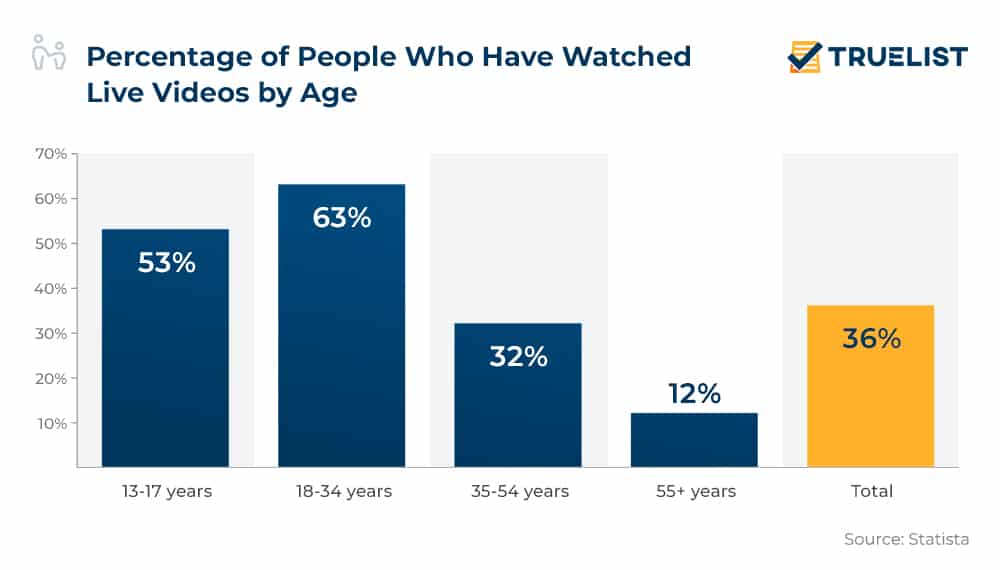
4. Live videos are preferred by 35% of marketers.
Live video marketing statistics reveal more than one-third of marketers are reaping the benefits of this type of digital marketing. The number of marketers who use live video marketing as a basic part of their media campaigns is growing by the year. Also, many marketers meanwhile intend to increase the use of live video because of the excellent results it delivers to their marketing campaigns.
(Influencer Marketing Hub)
5. 52% of consumers prefer free and ad-supported live streaming.
According to streaming stats, around 70% of video fans worldwide have streamed some form of video content. Additionally, 52% prefer this content to be ad-supported and free, as opposed to subscription-tied and à la carte services. The upside of this preference to streaming marketing is that 64% of people who streamed a live video engaged with an ad (pre-roll or sponsored).
(IAB)
6. Social media accounts for 52% of live video stream views in the US.
Over the years, social media has evolved and brought live streaming to the table. Live video statistics show that more than half of the live streaming audience comes from social media. The video streaming option has attracted big news companies like CNN, CBS, and FOX to stream their news on social media more often than usual. Social media live streaming is also widely used by commercial brands like Sony, Apple, and others as a way to announce new features and products and generate more buzz online.
(eMarketer)
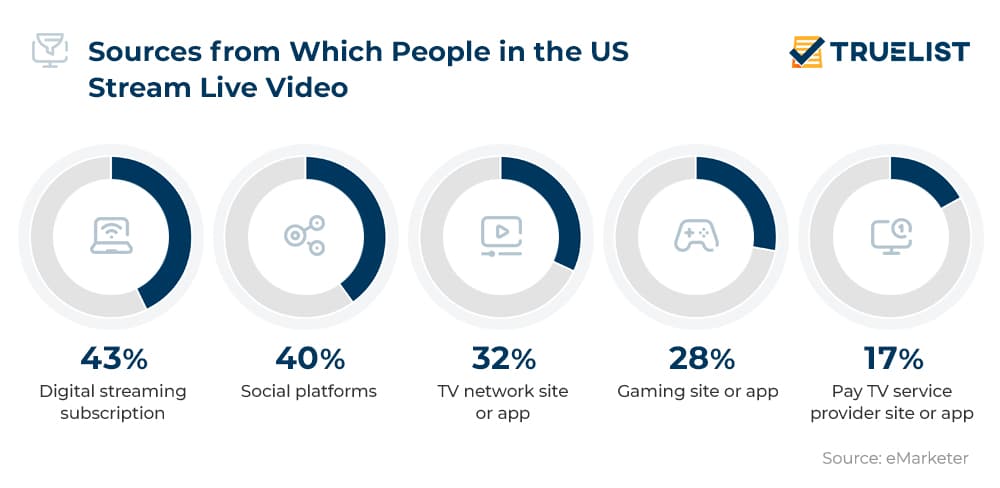
7. Live video usage was estimated to account for 13.2% of the global internet traffic by the end of 2021.
Streaming statistics based on Cisco’s estimations had suggested that live video usage would increase 15X in the next five years and account for 13.2% of global internet traffic by the end of 2021, pointing to an increase from 3.3% in 2016. The growing engagement of consumers and the growth of live streaming rather than article reading/writing has resulted in new projections. Namely, Cisco predicted that by the end of 2021, nearly 74% of all internet video traffic will be long-form video.
(Cisco)
8. Online video streaming statistics indicate people watched nearly 1.5 million years’ worth of live streams in 2019.
In 2019, all of us collectively watched an astonishing 1.5 million years of live streams. This translates to around 12.7 billion hours of live video, up by almost 2 billion compared to 2018 when we enjoyed 10.3 billion hours of live video.
(TNW)
Facebook Live Video Statistics
9. The watch time for Facebook Live broadcasts increased by 50% amid the coronavirus crisis.
The pandemic brought a lot of new cravings to the digital world. And one of the areas where Facebook benefited most was the 50% growth of live streaming viewers. The latest Facebook Live data reveal that there have been over 8.5 billion broadcasts in the US alone. Fidji Simo, the woman in charge of Facebook Video, said that the company will be focusing on making the experience more social and fun, to encourage people to gather in person and thus adapt to the shifting needs of its users.
(CNET)
10. For optimal engagement, Facebook videos should be 15 to 16 minutes long.
Facebook live video statistics show that in the period from the start until the 15-minute mark, the engagement of streamed videos on the social network increases exponentially. After that, the viewer count stabilizes and remains the same until the end of the video. This happens since not everyone receives live broadcasts notifications. Even though Facebook states there is no such delay, users have reported it on many occasions.
(BuzzSumo)
11. Facebook is the top live streaming platform in the US.
Facebook Live is the #1 live video streaming platform in the US, with 17% of the market share. Social media live streaming statistics further show that YouTube Live came in close with 16%. Snapchat ranked third with 12%, followed by Periscope and Twitter with 9% each, while YouNow wraps the list with 8%.
(Statista)
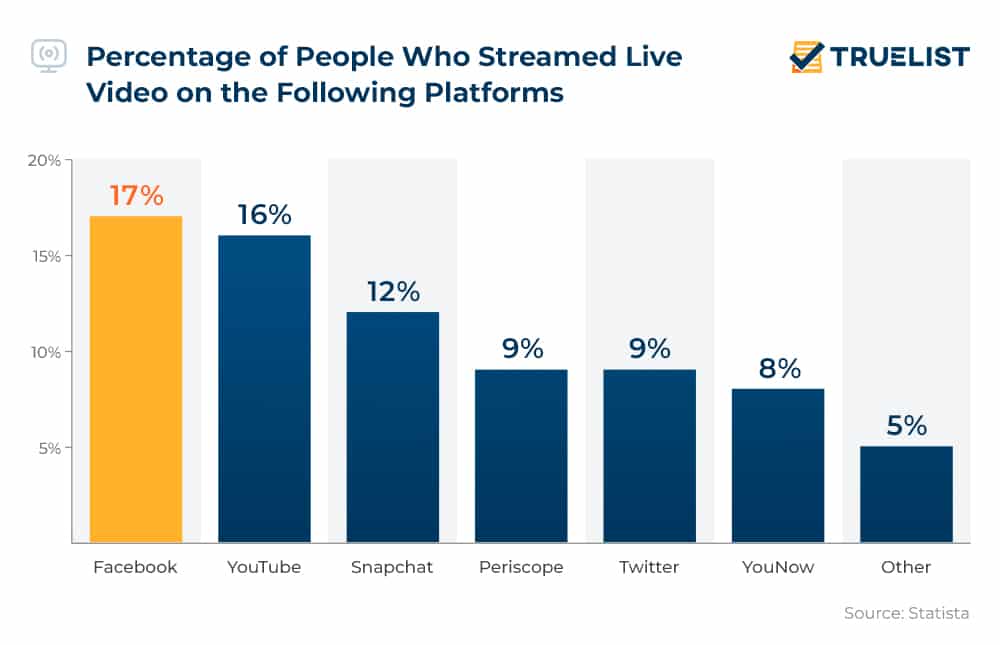
12. Facebook live videos generate 6 times more interactions than regular videos.
If you’re a marketer looking for insights on how top digital marketing companies boost their strategy with live video marketing, this might interest you. Facebook-streamed videos generate six times more comments than uploaded videos, according to Facebook live video stats. The main reason behind this is likely the new experiences that live videos bring to the user. Users now can express their excitement, opinions, and criticism, and discuss it all with the creator or other users.
(Biteable)
13. The phrase ‘Facebook Livestream’ noted a whopping growth in searches by 330% from 2016 to 2018.
Facebook Live was made available to celebrities back in 2015 and was launched for the rest of the social network’s community a year later. The feature has since seen a massive spike in daily searches coming from popular influencers and other big events. Since 2016, ‘Facebook Live’ searches have grown by 330%, according to Facebook Live stats.
(Blogging Wizard)
14. Facebook Live videos are watched three times longer than pre-recorded videos.
This is because everyone prefers the real deal, even more so if they can watch it in real-time, and a massive 79% of live video fans believe watching videos live brings a more authentic interaction with the audience. Live video engagement stats further reveal 63% of users like the human touch this medium adds to the overall experience.
(Go-Globe)
Twitch Live Streaming Statistics
15. In the first quarter of 2022, 6,129 million hours were watched on Twitch.
Twitch is the most popular platform for live video, surpassing YouTube Gaming Live, Facebook, and Mixer with a fantastic 6,129 million hours of streams in the 1st quarter of 2022. The number of Twitch’s monthly broadcasters meanwhile has surpassed 3.3 million, marking a 63.5% increase within a year. Another fun fact is that over 1.1 million viewers are hooked on Twitch at every second.
(Statista, Influencer Marketing Hub)
16. The top 10 Twitch streamers together make more than $20 million annually.
The latest Twitch video stats reveal that Richard Tyler Blevins, aka Ninja, is Twitch’s #1 streamer with 12 million followers and estimated annual revenue of $5,417,447. Gaming streamers benefit from affiliate links, selling merchandise, sponsors, and donations. Though, in addition to the money they earn, they are also reshaping the world as we know it.
(Influencer Marketing Hub)
17. Twitch stream stats point to TheGrefg as the platform’s all-time record holder with the highest peak viewers at 2,4 million.
TheGrefg is the stream with an all-time peak viewership of 2,470,347. Eleague TV—a stream that shows the biggest Esports competitions of games like Rocket League, Overwatch, Street Fighter, and others—comes second with an average of over 1 million viewers. With 1.5 million, Ibai is ranked second, while ELXOKAS comes in third with 1.2 million.
(Dexerto)
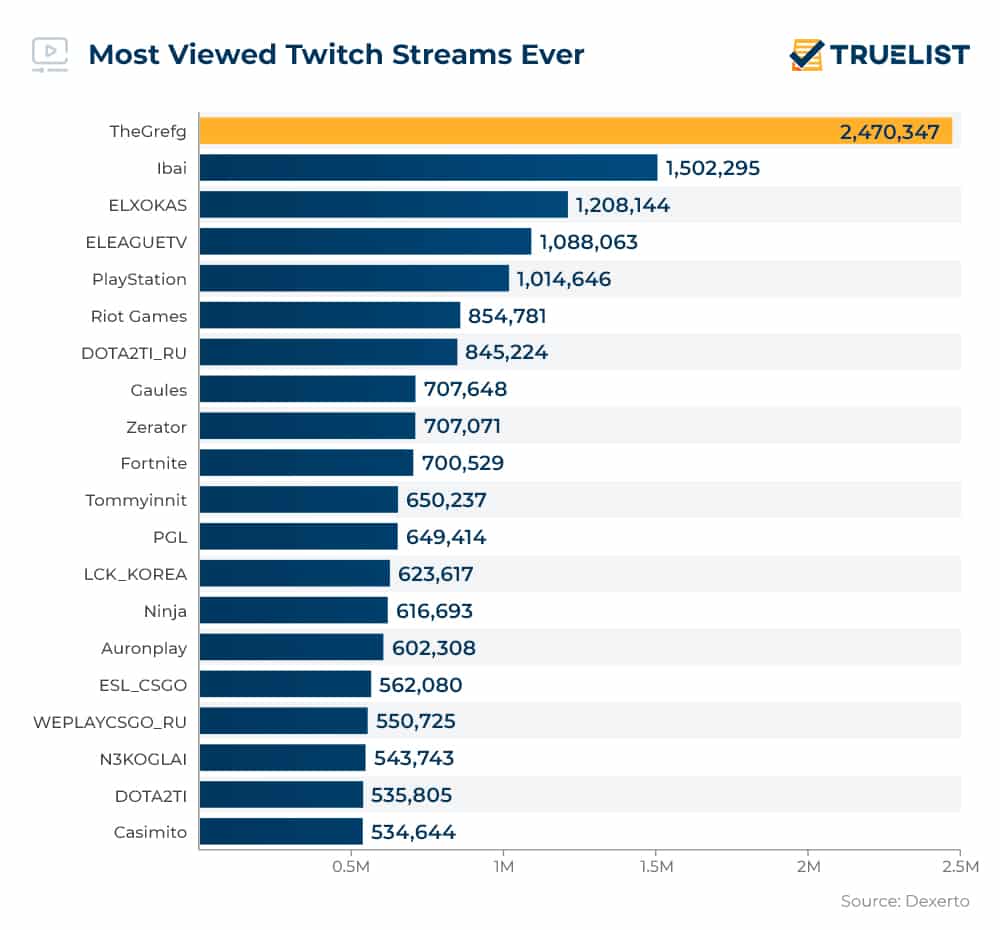
18. Just Chatting is the most-watched category on Twitch with more than 265 million hours.
Twitch stream stats show that Just Chatting is currently the most-watched live stream and has so far generated 2,884,401 hours of stream time from 556,587 streamers. In this category, the average viewers’ count is the highest with 368,770 per stream.
(SullyGnome)
19. The #1 streamed game on Twitch is Fortnite.
Fortnite has been streamed for more than 7 million hours. The game has 54,608,642 hours of watch time and 3,563,483 hours stream time with peak viewers reaching as high as 945,769 according to live video streaming statistics.
(SullyGnome)
20. Twitch streamers can make from $0.01 to $1 per viewer hourly.
To make money on Twitch, you must become an affiliate and partner. Becoming an affiliate requires having 50 followers and 500 minutes of streamed content in 7 unique days monthly. Becoming a partner requires a little more effort; you will need to stream at least 25 hours in 12 unique days per month and have 75 viewers on average.
(WalletHacks)
YouTube Live Video Statistics
21. 70% of viewers prefer YouTube over other live video platforms.
Many assume Facebook and Twitch to be the most popular platforms for live streaming but actual viewers say otherwise. In a recent survey done by Vimeo, 70% of respondents said that YouTube Live is their favorite platform and YouTube Live video statistics confirm it. Taking into account the growth that live video streaming is currently experiencing across the world, it seems we are yet to see YouTube Live achieve its full potential and perhaps come out as a leader in the live video market.
(Vimeo)
22. The number of unique monthly YouTube users worldwide stands at 2.6 billion.
According to YouTube Live stats, it is one of the few live video platforms that have been widely accepted by viewers because of their living-room footprint. Statistics further point out that more than one-fourth of the world population uses YouTube every month. Furthermore, YouTube Music and Premium together have over 50 million subscribers worldwide.
(Variety)
23. Felix Baumgartner’s space jump holds the record with 8 million views.
With 8 million views, Felix Baumgartner’s space jump is the most-watched YouTube live stream. This live stream is both extraordinary and historic in so many ways. As YouTube live stream statistics have it, while the record-breaking jump wrote history for humankind, with this stream and the 8 million concurrent views that go with it, YouTube made another record in the digital space. The second most-viewed stream on YouTube with 2.8 million views was the EasterSunday performance of Italian tenor singer Andrea Bocelli at the Duomo in Millan, Italy.
(The Wrap)
24. YouTube Gaming Live reached an average of 523 thousand viewers in the Q1 of 2022.
Twitch might be the ultimate platform for gamers but YouTube Gaming Live is firmly in the running. YouTube Live stats reveal 2020 was the biggest year ever for Gaming Live with 100 billion watch time hours. In travel time, it’s like going to Neptune and back 475,000 times. Amazing, right?! But stats also show a massive spike of over 40 million in the number of channels and video game live streams watch time growth to over 10 billion hours.
(Statista, YouTube)
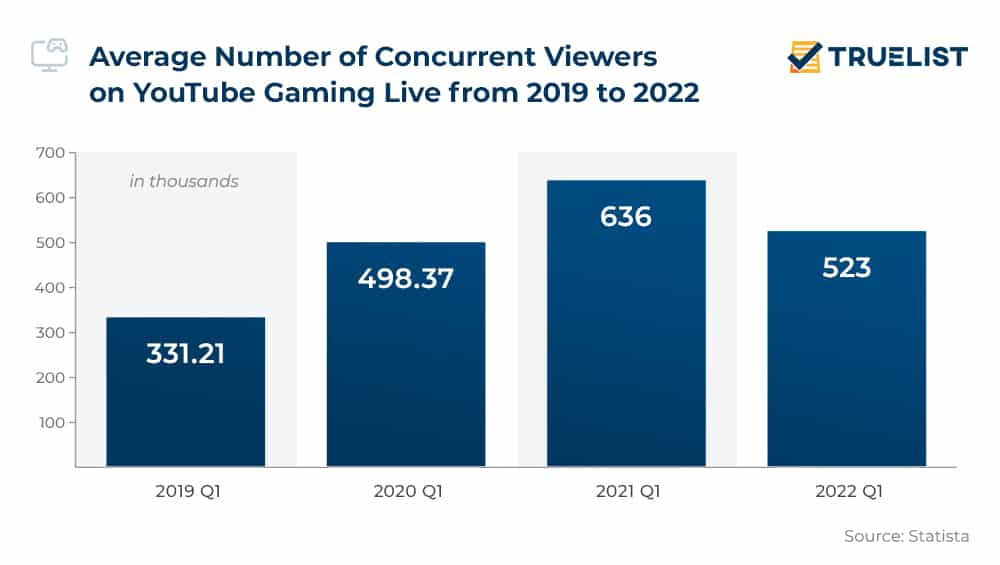
Live Video Marketing Statistics
25. 80% of brand followers would rather watch a live video than read an article from a company.
Four out of five people prefer to watch a live video rather than read an article from a brand. People often say that they can’t be bothered to read online because they don’t have the time or just feel tired. Instead, they relax watching videos and don’t get exhausted as much.
(Social Media Examiner)
26. Video streaming statistics show 45% of people will pay for a live stream video if it offers exclusive content.
Premium streaming is nothing new. Pay-per-view events existed on television way before they were adopted for online viewing. Whether that live stream video would be from their favorite band, inspirational speaker, or even their favorite brand, people are willing to spend money. Why? Because the vast majority (87%) want to watch live video streams and get that behind-the-scenes feel which evokes a more exclusive experience compared to a standard TV broadcast.
(InPlayer)
27. Businesses that use video can increase their revenue 49% faster.
Live streaming trends indicate that compared to businesses that don’t use video, organizations that incorporate this particular medium into their marketing strategy are poised to see year-on-year revenue growth 49% faster. This is especially important for SMEs that are looking to boost their market share. Through videos and live streams, companies engage with the customers directly which helps them establish and boost brand credibility.
(Clum Creative)
28. Social media live videos generate 10X more engagement than regular videos.
It is a psychological fact that there is a bigger chance for the user to react on a live video than to an uploaded one because the former is happening right now which makes it more relevant. Live video statistics reveal that social media users watch live content 3X longer. And since it’s in our nature to be more curious and to value information that we learn before others, users also feel 10X more engaged when provided with the opportunity to watch live videos.
(Business Insider)
29. 66% of marketers plan to invest more in creating Instagram Stories and videos.
Instagram live video statistics and trends indicate that digital marketers will push more for video content on the platform, including its streaming function. Additionally, B2B marketers are planning to focus more on newsfeed videos, while B2C marketers will use Instagram Stories more.
(Mondo Creative & Digital Trends)
Wrapping It Up
Streaming is not part of the future, it is already here and set to reshape the strategies of digital marketers. Live video statistics suggest that every time you develop a new product or service and want to show it to the public, it’s better to do it through a live video stream. You will not only connect with current and future users, but you will present yourself as a modern business that listens to its customers and values their feedback.
Sources: Grand View Research, IAB, Cisco, Biteable, Statista, Influencer Marketing Hub, Vimeo, Mondo Creative & Digital Trends, Livestream, Statista, Influencer Marketing Hub, eMarketer, TNW, CNET, BuzzSumo, Statista, Blogging Wizard, Go-Globe, Dexerto, SullyGnome, WalletHacks, Variety, The Wrap, Statista, YouTube, Social Media Examiner, InPlayer, Clum Creative

